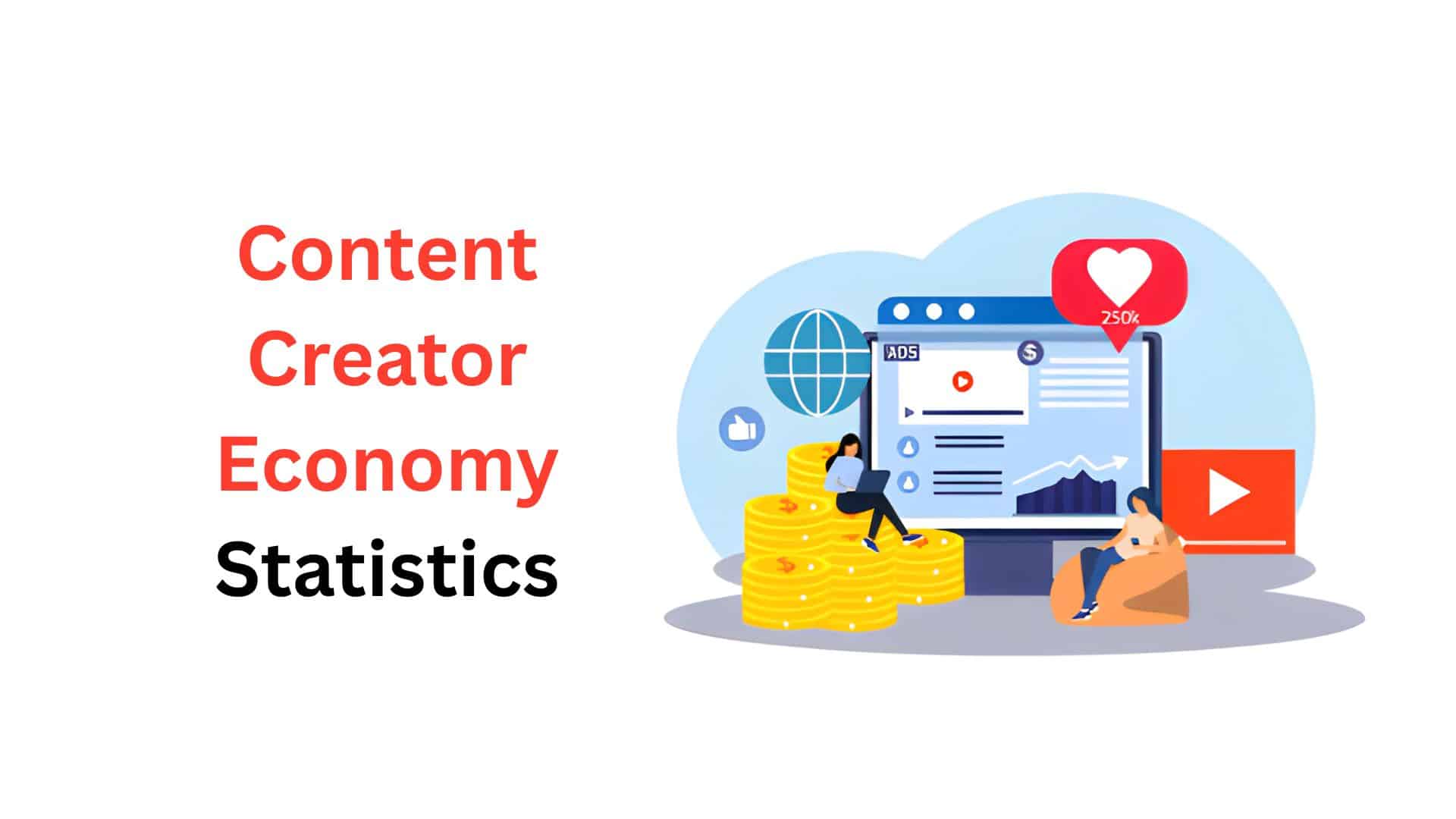Music Streaming Statistics By Platforms, Monthly Active Users and Facts (2025)

Updated · Oct 14, 2025

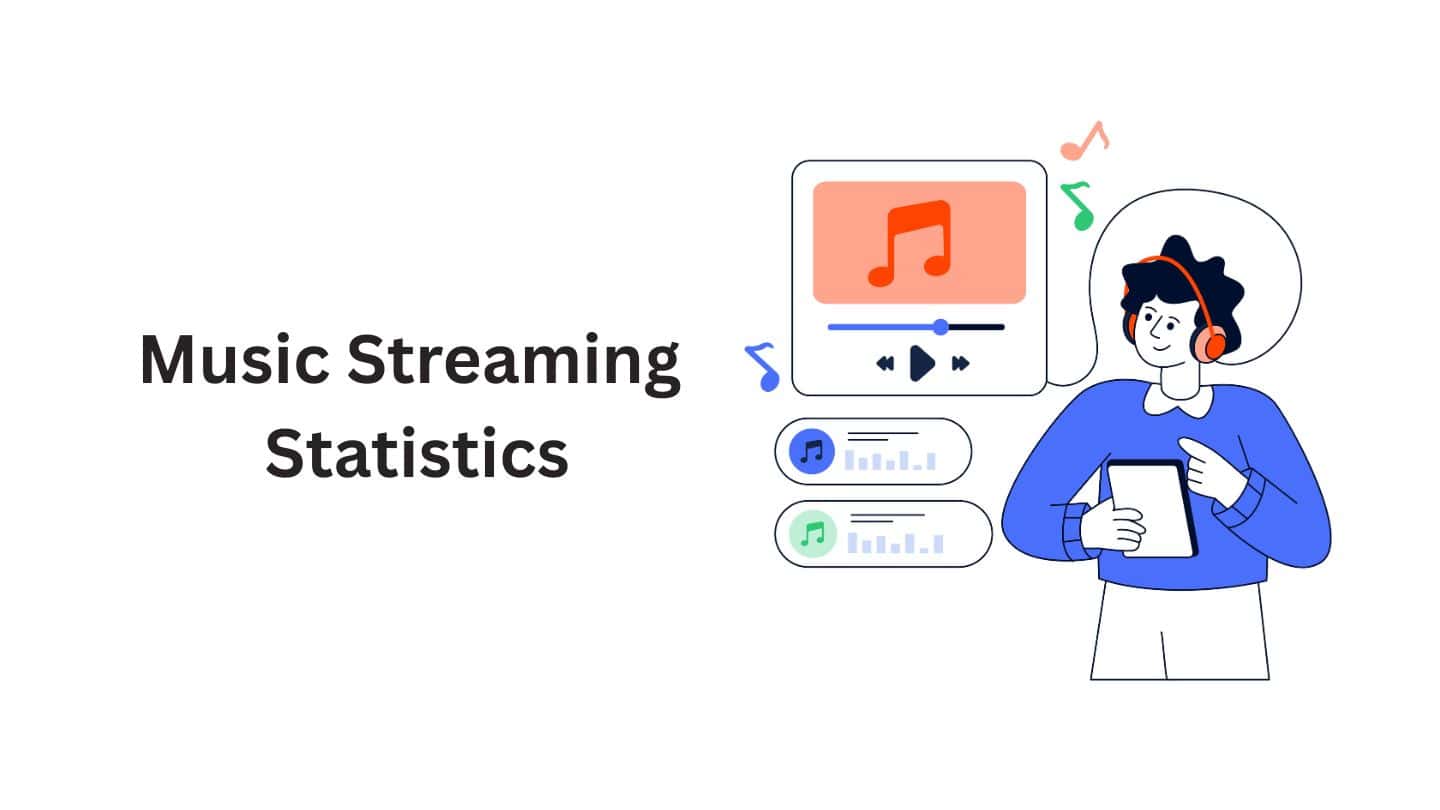
WHAT WE HAVE ON THIS PAGE
- Introduction
- Editor’s Choice
- How Many People Stream Music Globally?
- Music Streaming Market Size
- Music Streaming Users Statistics
- Music Streaming User Demographics
- Music Streaming by Country
- The Platforms of Head-to-Head Comparison
- Music Consumption Source Statistics
- Digital Music Statistics
- The Rise of AI in Music Streaming
- Conclusion
Introduction
Music streaming statistics: To put it simply, music streaming is one of the most popular industries today, with an amazing 713.4 million paid subscribers globally and a market generating over $28.6 billion in recorded music revenue. Streaming has fundamentally changed how we discover, consume, and interact with different songs and music. It now accounts for over 67% of the entire music industry’s earnings, a figure that has multiplied more than 15 times over the past decade.
Leading the charge are giants like Spotify, which boasts over 626 million total users, and YouTube Music, which leverages a user base of over 2 billion (with YouTube). The overall market for music streaming apps was valued at $49.5 billion in 2025 and is on an aggressive upward trajectory, with forecasts predicting it will smash the $100 billion mark by 2030. Countries like Nigeria are at the forefront of this digital wave, with an incredible 91% of its population engaging with digital music. From Gen Z’s listening habits to the per-stream payout rates for artists, the numbers tell a fascinating story of this in progress.
So, let’s dive straight into the most comprehensive collection of music streaming statistics 2025. If you are a music artist, a developer, or a business person, this will help you out. Let’s get into it.
Editor’s Choice
- The total number of paid music streaming subscribers worldwide has officially crossed 4 million. This marks a significant milestone, indicating that nearly 1 in 11 people on the planet pays for a music subscription.
- Revenue from music streaming is projected to reach $28.6 billion in 2025, constituting a massive 3% of all global recorded music revenues..
- An almost unbelievable 120,000 new tracks are uploaded to music streaming platforms like Spotify and Apple Music every single day..
- Spotify continues its reign as the market leader, holding a commanding 7% of the global subscriber market share.
- The platform has an impressive 239 million premium subscribers out of its 626 million total monthly active users.
- The United States is the largest single market for music streaming, generating over $12.9 billion in revenue annually. This represents 84% of the total music industry revenue within the country.
- Gen Z and Millennials (users under 35) make up the overwhelming majority of music streaming users, accounting for over 70% of listeners on major platforms.
- The average payout per stream to artists remains a hot topic, with platforms like Tidal paying the most at approximately $0.013 per stream. In contrast, a platform like Spotify pays artists between $0.003 and $0.005 per stream.
- The Asia-Pacific region, including countries like India and China, is the fastest-growing market for music streaming.
- It is projected to experience a compound annual growth rate (CAGR) of over 19% between 2025 and 2030.
How Many People Stream Music Globally?
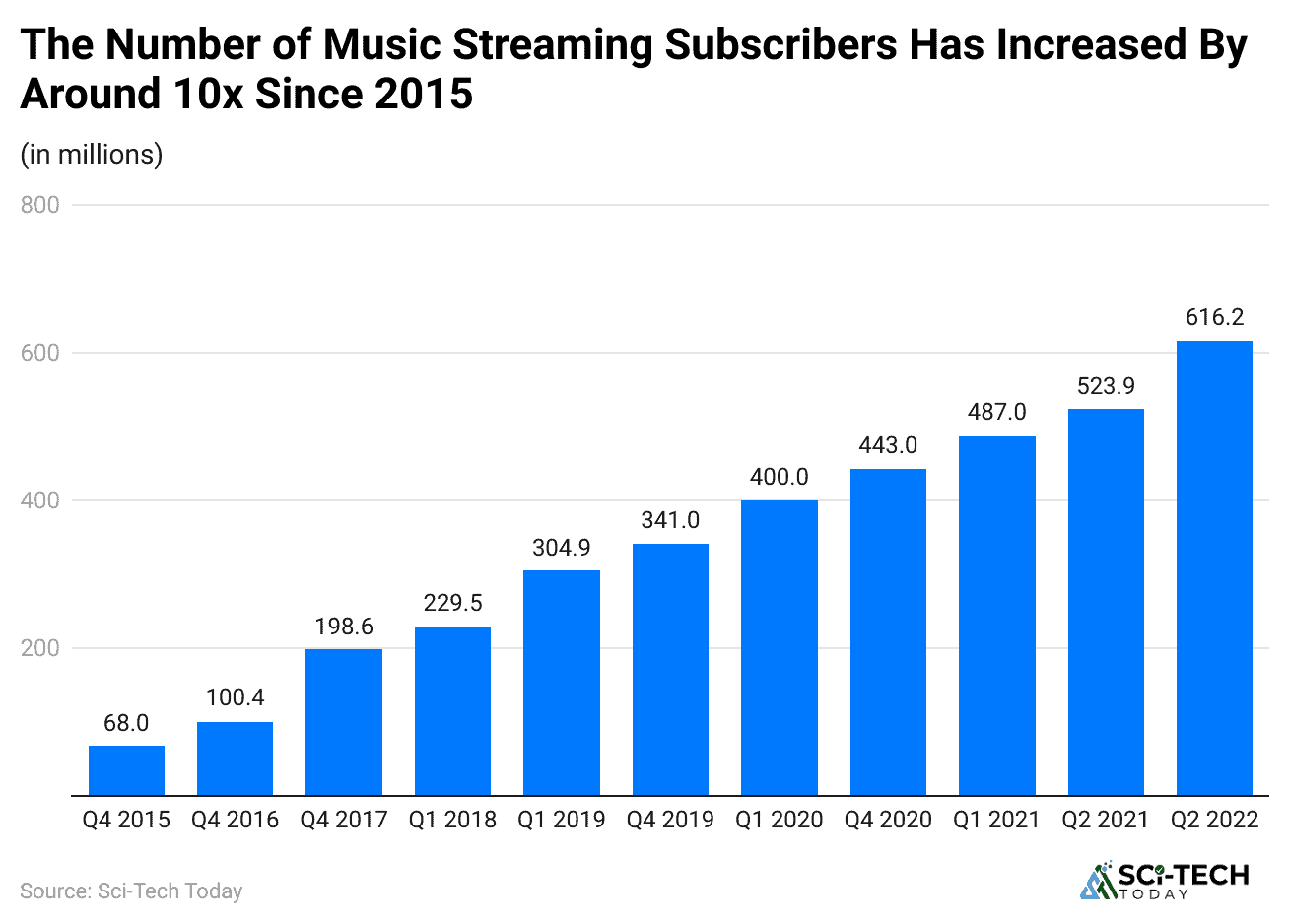
The global reach of music streaming is immense and continues to expand into new markets every year. The story is not just about the total number of users but also about the deepening engagement, with more people than ever willing to pay for premium, ad-free experiences..
- Globally, there are 713.4 million people who pay for a music streaming subscription as of early 2025. This number has seen a dramatic increase of nearly 12% from the previous year, showcasing robust and consistent growth in the paid sector.
- When including users of free, ad-supported tiers, the number of people who stream music swells to over 4 billion worldwide. YouTube is a massive contributor here, with over 2.5 billion users who engage with music content on its platform.
- Spotify alone accounts for 626 million monthly active users across both its premium and free tiers. This makes its user base larger than the entire population of North America, illustrating its incredible scale and cultural penetration.
- Projections indicate that the number of paid subscribers will surpass the 1 billion mark by 2028. This growth is being driven primarily by emerging markets in Asia, Latin America, and Africa, where smartphone penetration is rapidly increasing.
| Paid Subscribers Worldwide | 713.4 Million |
| Total Global Users (Incl. Free Tiers) |
4 Billion+ |
|
Spotify Monthly Active Users |
626 Million |
| Projected Subscribers by 2028 |
1 Billion+ |
Music Streaming Market Size
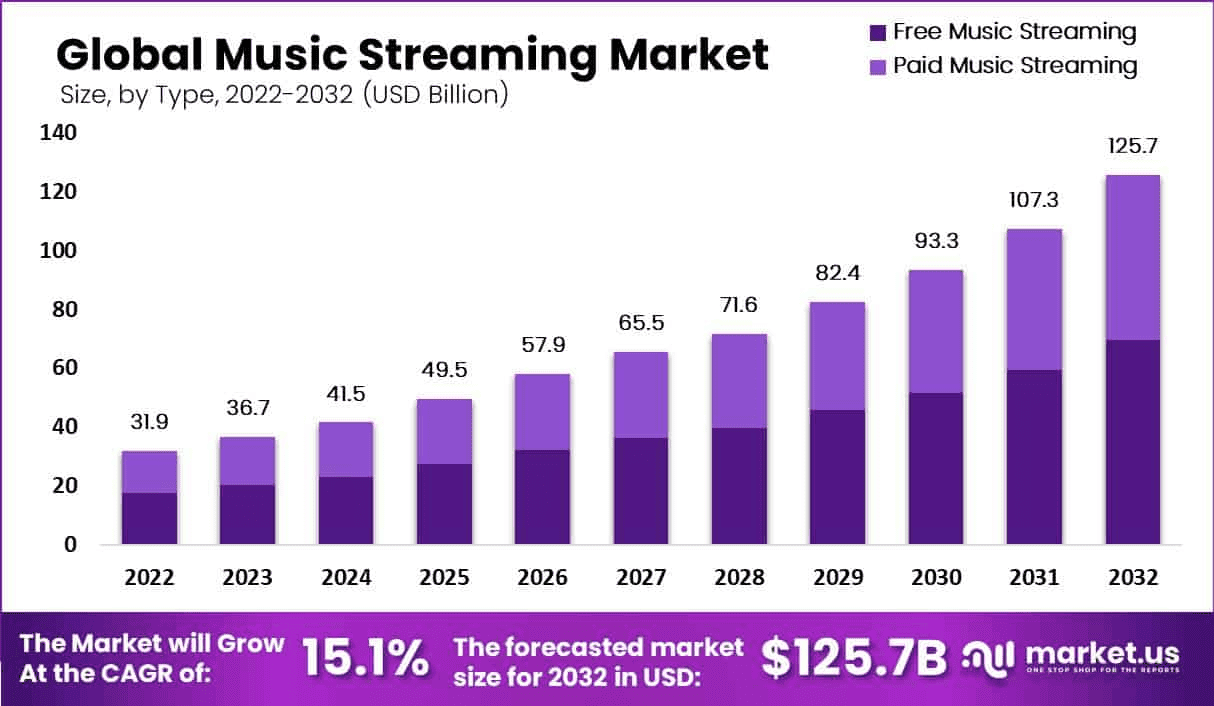
According to Market.us, the overall market for music streaming is experiencing a period of intense growth, transforming from a digital alternative into the primary engine of the global music industry. The numbers reveal a market expanding at a remarkable pace, driven by technology and shifting consumer habits.
- The global music streaming market generated USD 48.6 billion in 2024, is expected to reach USD 56 billion in 2025, and is projected to approach USD 200 billion by 2034 at a 15.2% CAGR.
- North America held a leading position in 2024 with a 33.3% revenue share worth USD 16.1 billion.
- Music streaming has become the main listening method worldwide, with about 67.3% of people using a streaming service for easy, on-demand access on multiple devices.
- Global paid subscribers increased from 68 million in 2015 to over 616 million in recent years, showing nearly a 10x rise.
- Listeners in the United States streamed over 4 trillion songs in 2023, indicating very high engagement.
- Streaming contributed about 84% of total music industry revenue, confirming clear dominance over physical sales and downloads.
- The spread of smartphones and reliable high-speed internet has enabled people to stream music anytime and anywhere.
- Paid plans generated roughly 72% of streaming revenue, signaling a strong preference for ad-free and higher-quality listening.
- Younger users led adoption, with 62% of people aged 25–34 paying for audio subscriptions and Gen Z representing 38% of all U.S. streamers.
- Smart devices and AI-based recommendations kept users engaged by serving relevant tracks and playlists.
- Spotify reported about 696 million monthly active users, including 276 million subscribers, showing the scale of personalized streaming.
- On-demand streaming held about 70.6% share due to flexible listening and tailored playlists.
- Mobile applications accounted for roughly 58.9% of usage, reflecting a shift to smartphone-centric listening.
- Audio content represented around 60.5% of consumption, supported by large music catalogs and rising podcast listening.
- Individual users contributed about 60% of demand, indicating that streaming is mainly a personal entertainment choice.
- North America contributed 33.3% of global revenue due to strong digital infrastructure, high subscription adoption, and the presence of leading platforms.
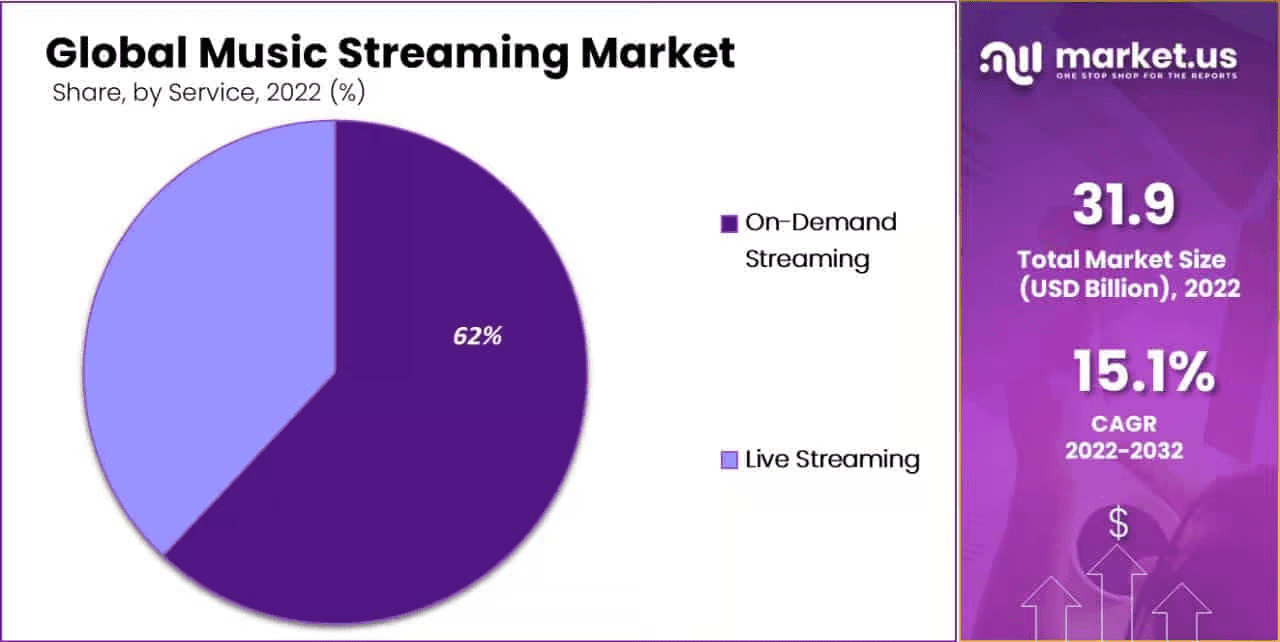
Music Streaming Users Statistics
- About two out of three people now listen to music through a streaming service, indicating broad mainstream adoption.
- An estimated 67.3% of listeners use some form of music streaming, showing that streaming is the preferred way to access music.
- Global paid subscriptions have grown by roughly tenfold since 2015, reflecting a sustained shift from downloads and physical formats to on-demand listening.
- The subscriber base expanded from 68 million in Q4 2015 to 100.4 million in Q4 2016, marking strong early momentum.
- By Q4 2017, subscriptions reached 198.6 million, which was almost double the prior year’s level.
- Growth continued to 229.5 million in Q1 2018 and 304.9 million in Q1 2019, as more markets and age groups adopted streaming.
- Subscriptions climbed to 341 million in Q4 2019 and further to 400 million in Q1 2020, supported by wider smartphone use and better data plans.
- The total rose to 443 million in Q4 2020 and 487 million in Q1 2021, indicating that churn stayed low and conversion to paid tiers improved.
- By Q2 2021, subscriptions stood at 523.9 million, and by Q2 2022 they reached 616.2 million, confirming durable, multi-year growth.
- Listeners in the United States streamed about 4.1 trillion songs in 2023, up from 3.4 trillion in 2022, which shows heavier usage per person and a larger audience.
- More than 80 million people in the United States use a premium music streaming service, pointing to strong willingness to pay for ad-free or higher-quality listening.
| Year | Music Streaming Subscribers | Increase Over Previous Year |
| Q4 2015 | 68 million | – |
| Q4 2016 | 100.4 million | +47.6% |
| Q4 2017 | 198.6 million | +97.8% |
| Q1 2018 | 229.5 million | +15.5% |
| Q1 2019 | 304.9 million | +32.8% |
| Q4 2019 | 341 million | +11.8% |
| Q1 2020 | 400 million | +17.3% |
| Q4 2020 | 443 million | +10.7% |
| Q1 2021 | 487 million | +9.9% |
| Q2 2021 | 523.9 million | +7.6% |
| Q2 2022 | 616.2 million | +17.6% |
Music Streaming User Demographics
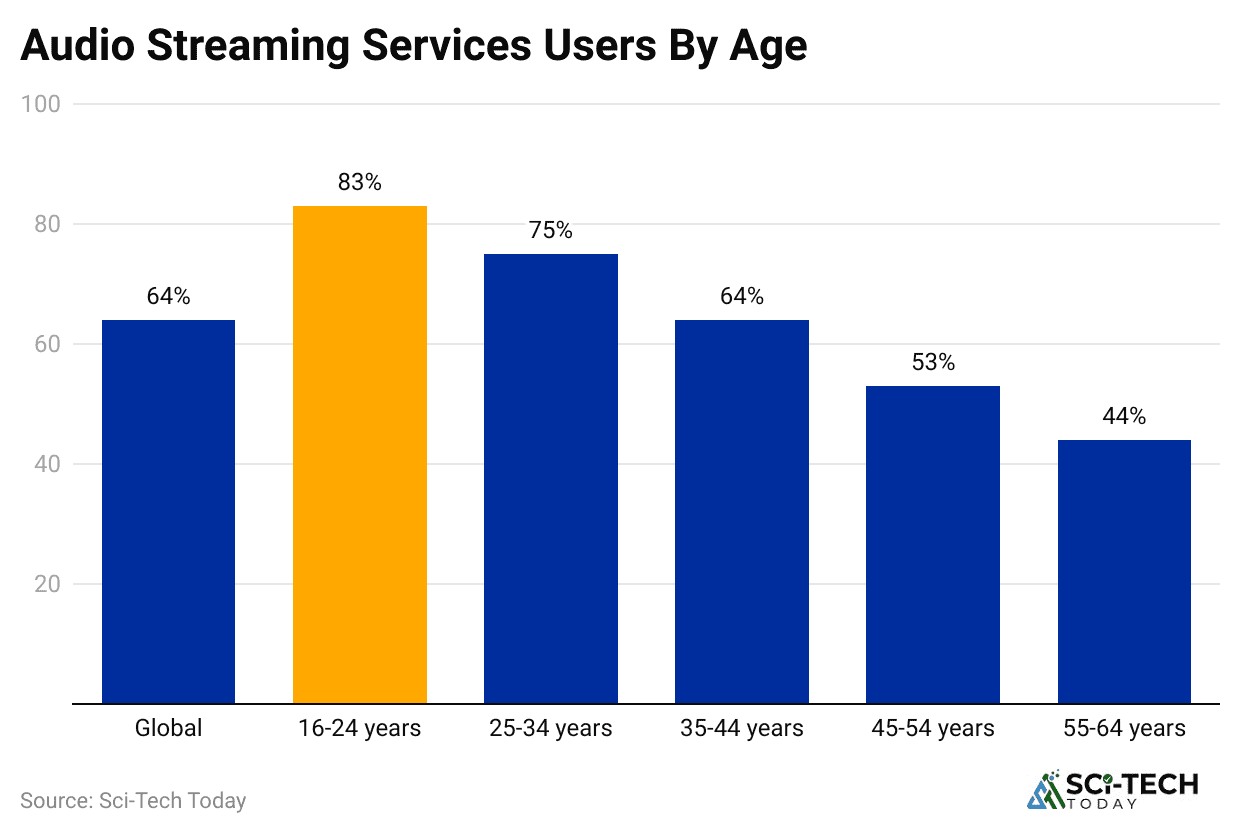
- Listeners under the age of 35 are the core audience, representing over 70% of all users on platforms like Spotify and Apple Music.
- Gen Z (ages 13 to 24) are the most active users, spending an average of 3.4 hours per day listening to streamed music.
- They are also the generation most likely to discover new music through social media platforms like TikTok and Instagram.
- While the user base is young, there is notable growth in the 45 to 54 age bracket, which has seen a 15% increase in streaming adoption over the past two years.
- In terms of gender, the split is nearly even, with 52% of Spotify users identifying as female and 48% as male.
- However, certain genres show significant skews; for instance, the audience for K-Pop and Pop music is predominantly female.
| Users Under 35 | 70%+ of Total Users |
| Gen Z (Ages 13 to 24) | 3.4 Hours of Daily Listening |
| Growth in the 45 to 54 Age Bracket | 15% Increase in Adoption |
| Gender Split (Spotify) | 52% Female / 48% Male |
Music Streaming by Country
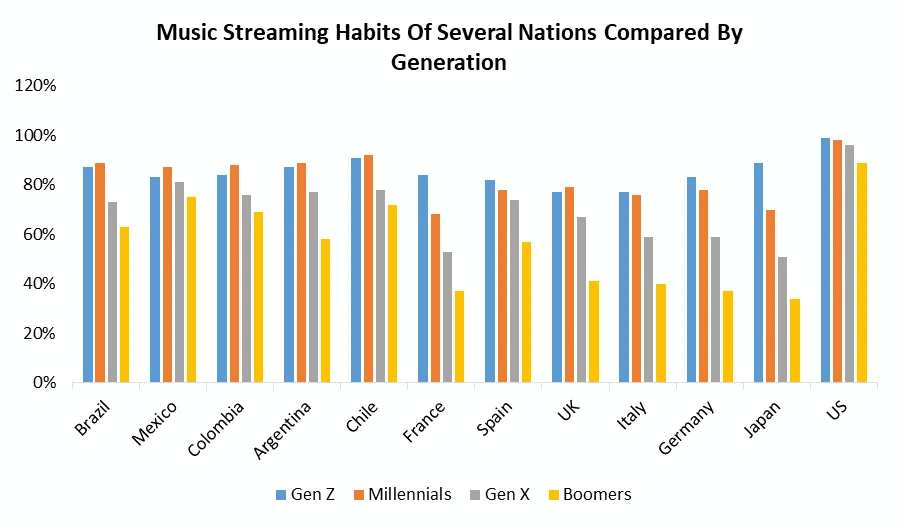
- Nigeria leads the world in digital music penetration, with an incredible 91% of its population engaging with digital music services. This is followed closely by the Philippines (88%) and South Africa (87%).
- The United States remains the largest market by revenue, generating $12.9 billion from streaming, which now accounts for 84% of its total music industry income. The U.S. has over 99 million paid music subscribers.
- In stark contrast, Japan, the world’s second-largest music market, has the lowest digital music adoption among major economies at just 64%.
- Sweden, the home of Spotify, has one of the highest adoption rates in Europe at 83%. Meanwhile, India’s streaming market is one of the fastest-growing, with revenue expected to reach 2.5 billion INR by the end of 2025.
| Nigeria | 91% Digital Music Penetration |
| United States | $12.9 Billion in Revenue |
| Japan | 64% Digital Music Penetration |
| India | 2.5 Billion INR in Revenue |
| Sweden | 83% Digital Music Penetration |
The Platforms of Head-to-Head Comparison
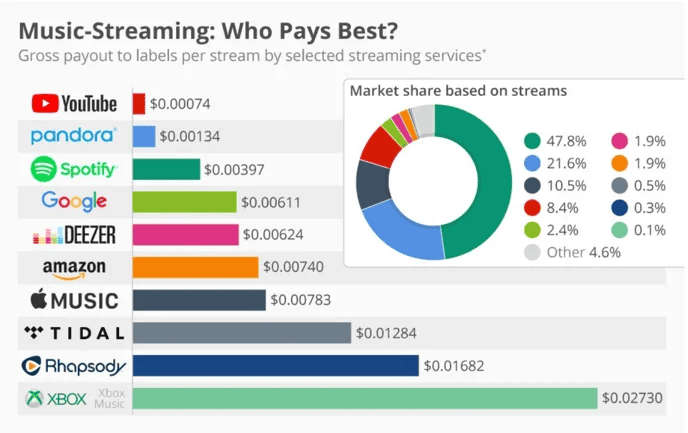
- When it comes to paying artists, Tidal leads the industry with an average payout of $0.013 per stream. This means an artist needs approximately 77,000 streams on Tidal to earn $1,000.
- Apple Music offers a competitive rate, paying artists around $0.01 per stream. To earn $1,000 on Apple Music, an artist would need about 100,000 streams.
- Spotify, despite its massive user base, has a more complex and generally lower payout rate, averaging between $0.003 and $0.005 per stream.
- This means an artist requires between 200,000 to 333,000 streams to earn that same $1,000.
- YouTube Music has the lowest payout rate among the major players, at approximately $0.002 per stream.
- An artist would need a 500,000 streams to earn $1,000 from the platform.
| Tidal | $0.013 | 77,000 | 5 Million |
| Apple Music | $0.010 | 100,000 | 108 Million |
| Amazon Music | $0.004 | 250,000 | 92 Million |
| Spotify | $0.004 | 250,000 | 239 Million |
| YouTube Music | $0.002 | 500,000 | 100 Million |
Music Consumption Source Statistics
- Paid music streaming represents about one-quarter of all music listening, equal to 23% of total consumption.
- Video streaming contributes 22% of music listening worldwide.
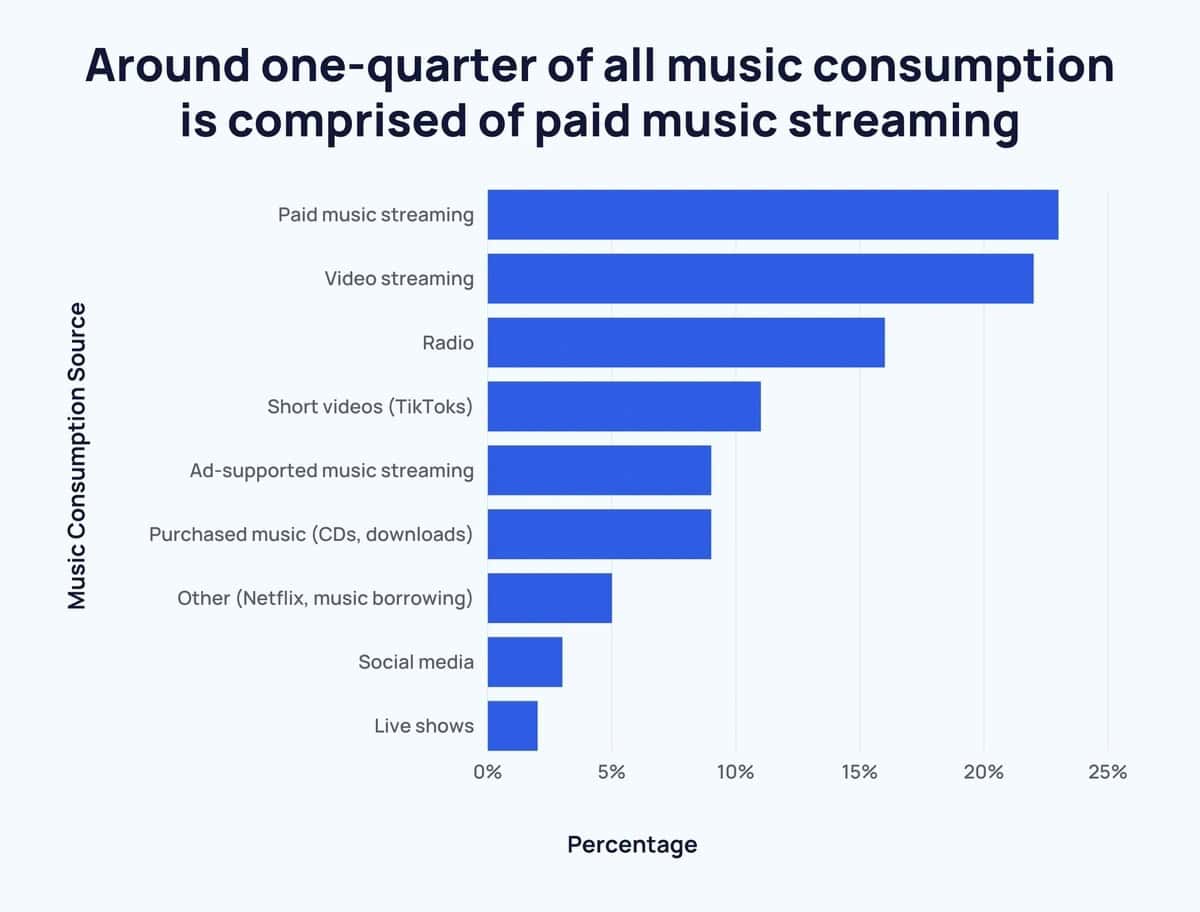
(Source: Exploding Topics)
| Music Consumption Source | Percentage |
| Paid music streaming | 23% |
| Video streaming | 22% |
| Radio | 16% |
| Short videos (TikToks) | 11% |
| Ad-supported music streaming | 9% |
| Purchased music (CDs, downloads) | 9% |
| Other (Netflix, music borrowing) | 5% |
| Social media | 3% |
| Live shows | 2% |
- Traditional radio accounts for 16% of music listening.
- Short-form video apps such as TikTok provide 11% of music listening.
- Ad-supported music streaming contributes 9% of music listening.
- Purchased music including CDs and downloads makes up 9% of music listening.
- Other sources such as Netflix and music borrowing together contribute 5% of music listening.
- Social media platforms supply 3% of music listening.
- Live shows account for 2% of music listening.
- Music streaming platforms generate 67% of global music industry revenue, which indicates that streaming is the main source of income for the industry.
- Physical formats now contribute 16.1% of global music revenue, showing a much smaller role than streaming.
- In the United States, streaming provides 84% of music industry revenue, demonstrating very high dependence on streaming services.
- In the United States, physical sales contribute 11% of music revenue, which is a minor share compared with streaming.
- Global music streaming revenue is projected to reach $30 billion in 2027, indicating continued growth for the streaming model.
Digital Music Statistics
- It is expected that global music streaming revenue will reach $30 billion in 2027, based on Statista data.
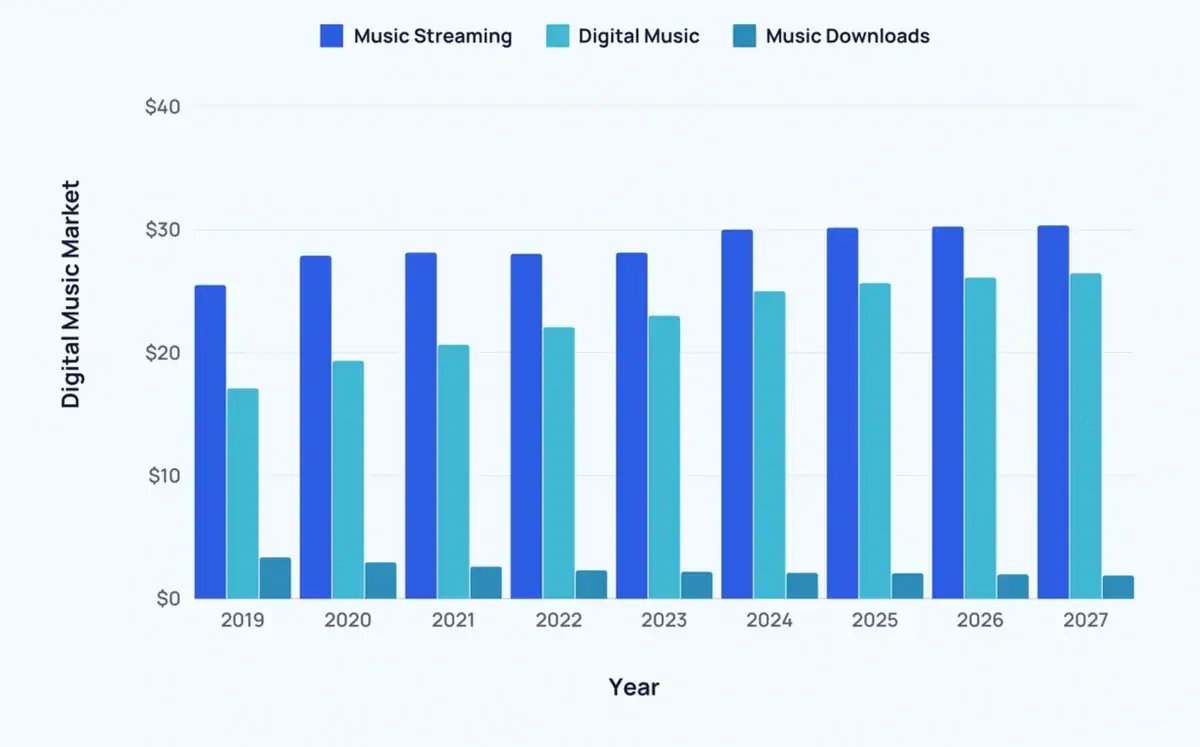
(Source: Exploding Topics)
- The average revenue per user in streaming and digital music is likely to keep rising, although growth is projected to level off over time.
- In 2019, music streaming made $25.48 billion, digital music earned $17.09 billion, and music downloads brought in $3.36 billion.
- In 2020, streaming revenue reached $27.87 billion, digital music totaled $19.33 billion, and downloads amounted to $2.96 billion.
- In 2021, streaming was $28.12 billion, digital music generated $20.64 billion, and downloads came to $2.61 billion.
- In 2022, streaming recorded $28.02 billion, digital music stood at $22.06 billion, and downloads were $2.32 billion.
- In 2023, streaming came in at $28.12 billion, digital music rose to $22.99 billion, and downloads declined to $2.20 billion.
- In 2024, streaming is estimated at $29.99 billion, digital music is projected at $24.98 billion, and downloads are seen at $2.11 billion.
- In 2025, streaming is forecast at $30.14 billion, digital music is expected at $25.64 billion, and downloads are predicted at $2.08 billion.
- In 2026, streaming is anticipated at $30.24 billion, digital music is likely at $26.10 billion, and downloads may be $1.98 billion.
- In 2027, streaming is projected at $30.33 billion, digital music is estimated at $26.44 billion, and downloads are expected to reach $1.89 billion.
The Rise of AI in Music Streaming
- The global AI in music market was valued at USD 5.20 billion in 2024 and is projected to rise from USD 6.65 billion in 2025 to about USD 60.44 billion by 2034, reflecting a 27.80% CAGR during 2025 to 2034.
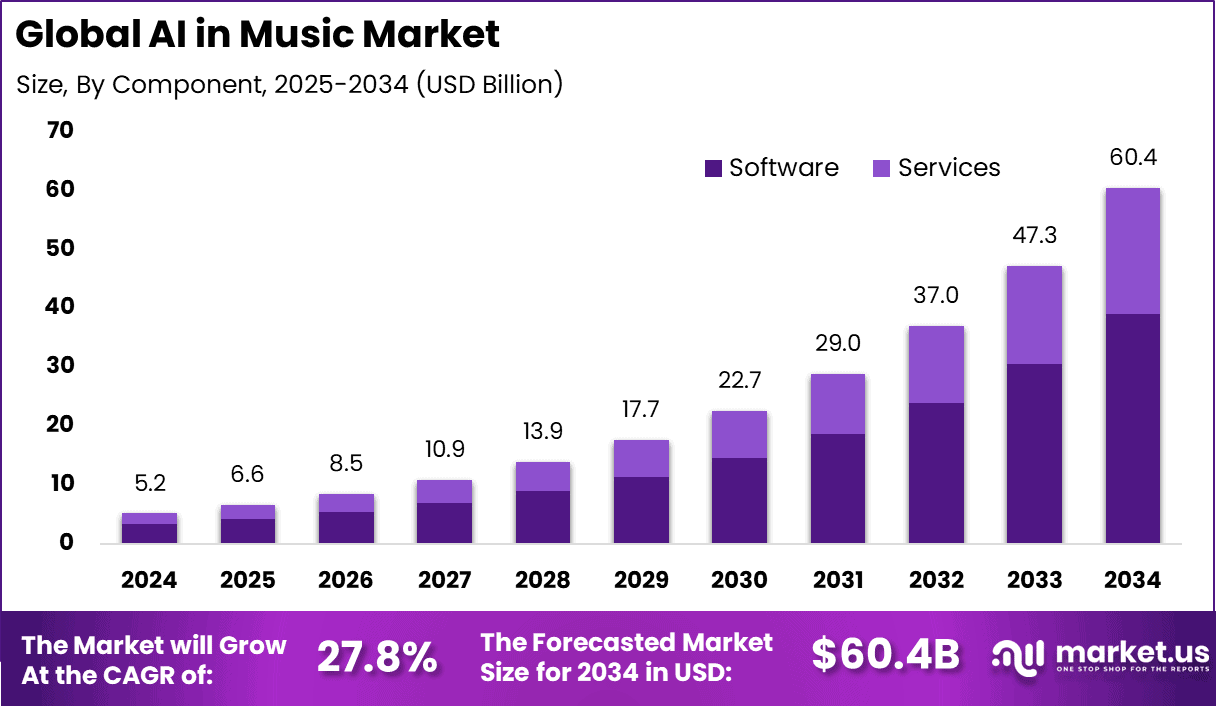
- It is reported that 60% of musicians already use AI tools for creating and producing music.
- A survey indicates that 77% of respondents worry that AI-made tracks may fail to credit original artists, which can create copyright risks.
- Generative AI in music is forecast to reach roughly USD 2,660 million by 2032, up from USD 294 million in 2023, implying a 28.6% CAGR across 2024 to 2033.
- AI can compose music dramatically faster, producing pieces up to 20 times quicker than humans.
- Adoption across creative tasks is spreading, with 20.3% of artists using AI for production, 30.6% using AI for mastering, and 38% employing AI for artwork.
- Overall sentiment remains favorable, as 40% of artists view AI positively and 39% believe it supports their personal goals.
- Despite this momentum, AI-written songs represent only 1.5% of plays on leading UK radio stations.
- Streaming platforms apply AI to gauge song mood and predict listener choices with about 86% accuracy.
- Algorithmic suggestions shape behavior, with roughly 30% of music consumption on platforms such as YouTube driven by AI recommendations.
- In 2024, the software category was the largest component, accounting for 64.7% of the market.
- Cloud deployment dominated in 2024, representing 73.5% of implementations.
- Automated music composition was the leading application in 2024, holding a 37.2% share.
- Music production and recording remained a core use case in 2024, contributing 33.9% of demand.
- The U.S. AI in music market reached USD 1.66 billion in 2024 and is growing at a 26.0% CAGR.
- North America led in 2024 with more than 37.6% of global revenue.
- Around 74% of internet users have used AI at some point to discover or share music.
- Revenues from AI-generated music are expected to surpass USD 6 billion by 2025.
- AI systems can create a basic melody in under 2 seconds.
- A large share of listeners, about 82%, report that they cannot reliably tell human-composed music from AI-composed music.
- The AI music platform Amper Music raised USD 4 million in seed funding to speed up product development.
- More than 50% of top twenty global streaming hits are influenced by AI-driven recommendation engines.
- AI-generated music is expected to lift overall music industry revenue by about 17.2% in 2025.
Conclusion
In summary, the world of music has been irrevocably transformed by streaming. The data shows a landscape of unprecedented scale, growth, and technological development. From the millions of subscribers to the trillions of streams, these music streaming statistics confirm that we are living in a new golden age of music access, with the change showing no signs of slowing down. I hope you like this piece of content. Thanks for staying up till the end.
Sources
FAQ.
As of 2025, there are over 713.4 million paid subscribers to music streaming services globally. When you include users on free, ad-supported plans (like YouTube and Spotify’s free tier), that number expands to over 4 billion people, showcasing the massive global reach of digital audio.
Spotify is the no. 1 music streaming service by a significant margin. It commands 31.7% of the global subscriber market share and has over 626 million monthly active users, making it the most dominant platform for both paid and free listeners.
Artist payouts vary significantly. Apple Music pays approximately $0.01 per stream, meaning an artist needs about 100,000 streams to earn $1,000. Spotify’s payout is lower, averaging between $0.003 and $0.005 per stream, requiring 200,000 to 333,000 streams to earn the same amount.
Based on current data, Tidal pays artists the most, with an average payout of around $0.013 per stream. This is significantly higher than most other major platforms and requires the fewest streams (around 77,000) for an artist to earn $1,000.
In 2025, the global music streaming market is valued at $49.5 billion. It’s projected to grow rapidly with a strong CAGR of 14.8%, and forecasts expect it to reach a massive $108.39 billion by 2030.
Yes, by a massive margin. Music streaming now accounts for 67.3% of all global recorded music revenues. In contrast, physical sales (including CDs and vinyl) have fallen to just a fraction of the market, making streaming the undisputed dominant format.
The main audience is overwhelmingly young. Listeners under the age of 35 (Gen Z and Millennials) make up over 70% of all users on major platforms. Gen Z (ages 13 to 24) are the most active “power listeners,” driving trends and new music discovery.
An astonishing 120,000 new tracks are uploaded to music streaming services like Spotify and Apple Music every single day. This highlights the immense volume of content being created and the significant challenge artists face in getting their music discovered.
Nigeria leads the world in digital music adoption, with an incredible 91% of its population engaging with music streaming and digital downloads. This is higher than in developed markets like the United States (84%) and the UK.
AI is having a huge impact in two main ways. First, it powers personalization features like Spotify’s ‘Discover Weekly,’ which drives over 30% of new music discovery. Second, the AI-generated music market is exploding and is projected to be worth $17.2 billion by 2028, creating a new wave of content and competition for human artists.

Barry is a technology enthusiast with a passion for in-depth research on various technological topics. He meticulously gathers comprehensive statistics and facts to assist users. Barry's primary interest lies in understanding the intricacies of software and creating content that highlights its value. When not evaluating applications or programs, Barry enjoys experimenting with new healthy recipes, practicing yoga, meditating, or taking nature walks with his child.




